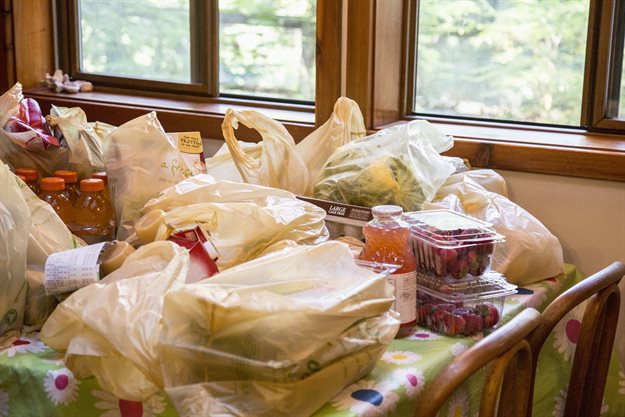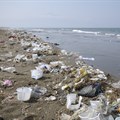With the plastic bag levy increased for the fourth time in the 2020 Budget Speech, who will bear the cost? Will the levy merely create perverse incentives, or will it ultimately address the plastic pollution challenge in South Africa?

Image source: Gallo/Getty
Current pressure on stakeholders to respond to the plastic pollution challenge has resulted in an increasing number of actions across the plastic value chain. Governments in all parts of the world have deployed policy and economic instruments, such as bans and product taxes, to dis-incentivise the production and consumption of “single-use” plastic products and packaging. Plastic carrier bags have been the first to be targeted and have been banned or levied (under various conditions) by more than 30 African governments (SA’s levy was introduced 17 years ago).
In Wednesday’s 2020 Budget Speech, the finance minister announced that the plastic bag levy would be increased to 25 cents, which is more than a 100% increase.
Delivering retailer profit
The plastic carrier bag is commonly sold at 60 cents (per 24L bag) at all major retailers, and what was previously ‘free’ to consumers now has the potential to deliver profit for the retailer. With 12 cents per bag currently going to the national fiscus, and the production costs paid by the retailers for bags with high recycled content varying between 30 – 40 cents (depending on bag size), this leaves approximately 10c for the retailer. There is further criticism leveled at the uneven approach to the policy in that only the 24L bags that are National Regulator for Compulsory Specifications (NRCS) approved with thickness of 30 microns are ‘taxed’. All other plastic bag formats such as barrier bags (for fruits and veg) and imported bags do not fall under this regulation. 24L carrier bags with a thickness under 30 micron were banned back in 2003 as part of this regulation. Apparel outlets do not charge the consumer for their carrier bags, but these bags are still regulated by NCRS in formal outlets.
Even with this limited application, in 2018 the levy brought in R241m revenue into the fiscus, which amounts to over 2 billion bags sold through formal retail channels (excluding the informal sector).
Regardless of the actual figures, there is a question to be asked about the possibility of retailers ringfencing the funds from the bags to help solve the plastic pollution challenge. National Treasury has not responded to calls for funds to be ringfenced, but perhaps the retailers will.
At very least, with this increase in levy, it must be asked: Will the retailers absorb the additional cost, or will they simply pass it on to consumers as they have been doing since the launch of the levy in 2003?
This will be the fourth time the levy has increased since it launched in 2003 at a rate of 3 cents/bag, along with a ban on bags with a thickness below 30 microns. Following the implementation of the levy, consumption reduced initially, but once the cost of the carrier bags were included into household budgets, consumption increased again and so did the levy (which increased to 4 cents/bag in 2009, and then to 6 cents/bag in 2013, and then to 8 cents/bag in 2016, and finally to 12 cents/bag in 2017).
The introductory price at all formal retailers was fixed at 46 cents/bag, but as the levy increased, so did the price of the bag.
Ifenna Ilechukwu 10 Dec 2019 Bans and levies unsuccessful
The goal of the levy to reduce consumption has ultimately failed. Bans and levies currently in place have been unsuccessful due to lack of enforcement specifically in the informal sector, along with the relatively low cost per bag and the lack of affordable alternatives1. However, more and more retailers are making reusable carrier bag alternatives available at as low a price as R5, however, many such alternative bags are also not reused. Consumers then largely still buy the cheaper bags each time they shop, and don’t reuse them to carry groceries, but rather as bin liners which then end up in landfills or dumps2. Many consumers also forget their reusable shopping bags at home or in the car and are thus forced to buy another bag at the till point – and opt for the cheapest option.
A key contextual factor is that the consumer market is defined and segmented into high-, middle-, and low-income households. High income households would scarcely notice a few cents increase in the cost of a bag. Low-income households will notice the increase, but may still continue to buy the plastic carrier bag because the alternative is too expensive. They will also reuse the bag a few more times for bin liners or other uses.
But with an evidently failed levy, and mounds of plastic waste (with plastic bags but one of the many problematic items) still ending up in nature, should government continue to use this blanketed approach? Should retailers continue to pass the cost to consumers? Or should the focus move toward developing more systemic change – with context and consumer segmentation in mind?
Disincentivising production, consumption of virgin plastic
The plastic carrier bag is the perfect example of circularity as the formal retailers require up to 100% recycled content in these bags and many are recycled in practise in South Africa – in some cases even if used to carry trash and sent to landfill. We need to move to a point where the production and consumption of virgin plastic is disincentivised through taxes or levies in order to shift the market demand to recycled plastic and ultimately support the struggling local plastic recycling industry.
In summary, the levy is problematic in that it has ultimately been unsuccessful in reducing consumption of bags and an increase to the levy may not result in any significant behavioural change on the part of the consumer and simply further profit the retailer. A better approach would be for the retailer to carry the cost of the additional levy, for the profit retailers are gaining from charging for bags to be ringfenced to help address plastic pollution, and for the country not to make the mistake of seeing a plastic bag levy as a significant win in the fight against plastic pollution, but rather as one intervention in what needs to be a suite of interventions right across the plastics value chain in order to make the shift we require to address the plastic problem in South Africa.
Sources:
1. Dikgang, J., Leiman, A. & Visser, M. 2010. Analysis of the Plastic-Bag Levy in South Africa. Policy Paper Number 18. University of Cape Town.
2. Dikgang, J., Leiman, A. & Visser, M. 2010. Analysis of the Plastic-Bag Levy in South Africa. Policy Paper Number 18. University of Cape Town.



































